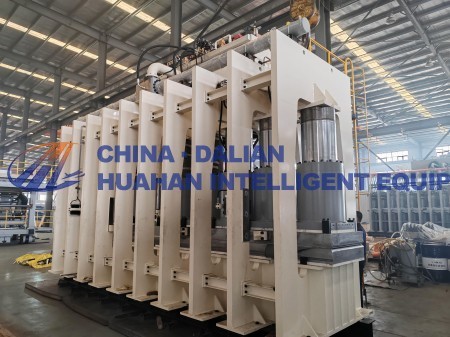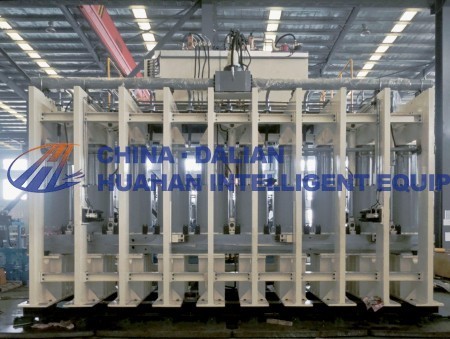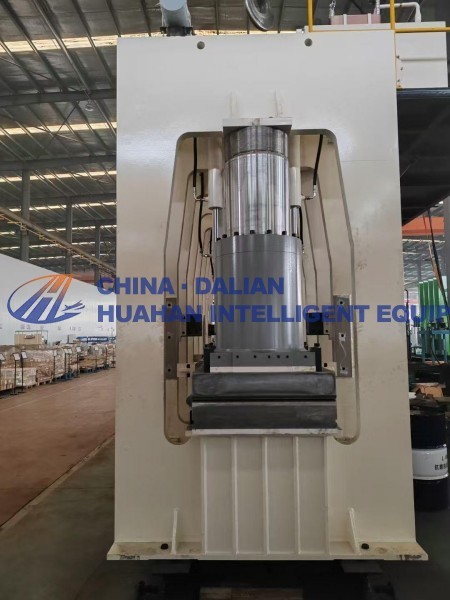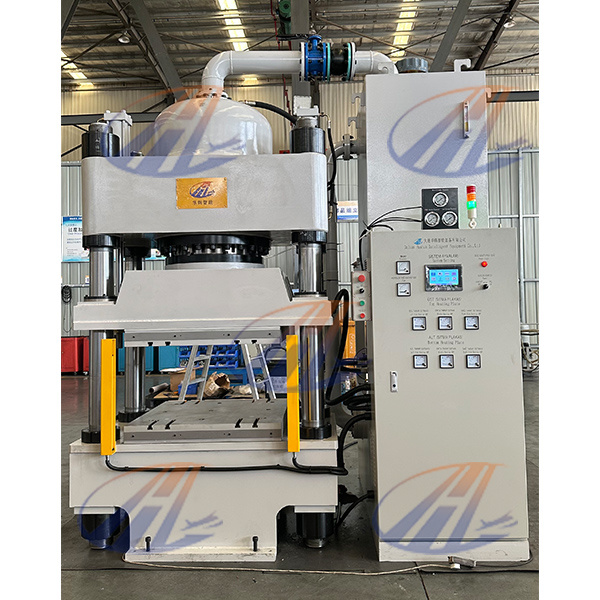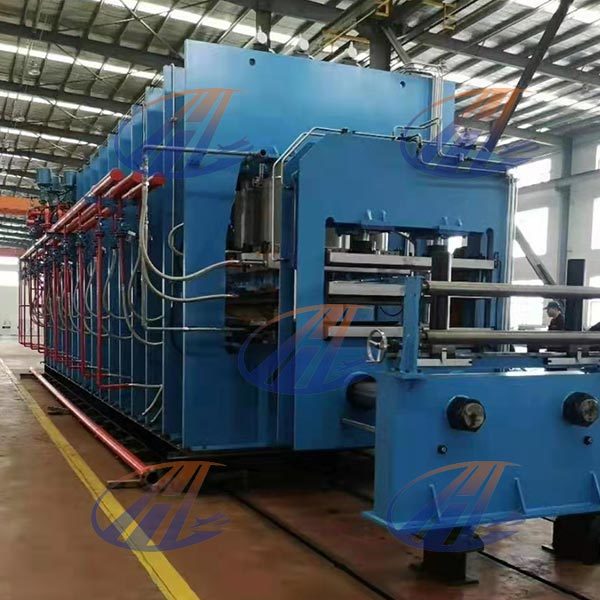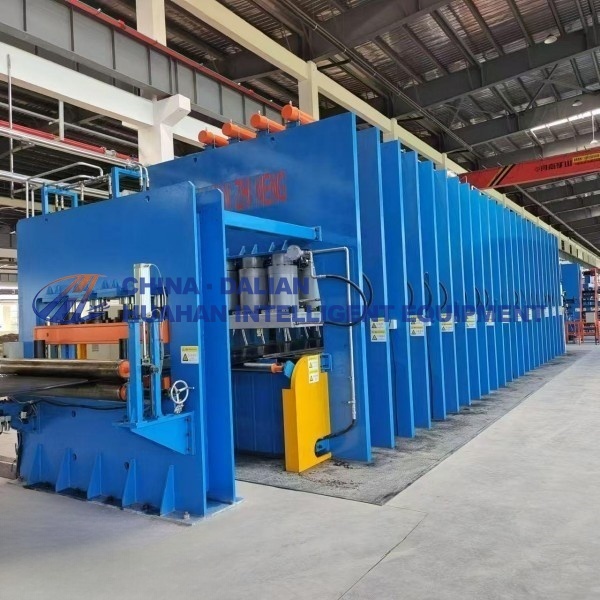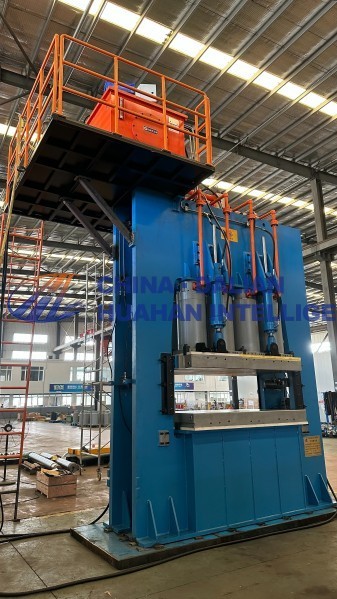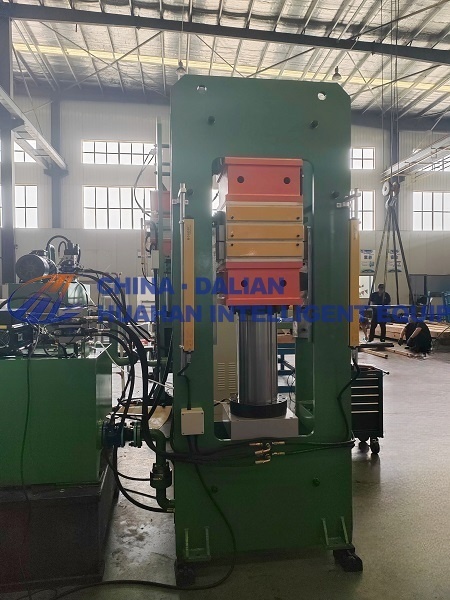Product classification
800*6500 Top-mounted vulcanizing machine
Key words:
Huahan Intelligence
Classification:
Product Description
一、 Structural design and working principle:
Structural composition: 800*6500 The top-mounted vulcanizer is mainly composed of a frame, a vulcanizing device, a hydraulic control system and other parts. The frame is used as an overall supporting structure, usually with a solid base and multiple door-shaped frame plates evenly arranged in a specific direction. The upper ends of each frame plate are firmly connected by connecting braces. The vulcanizing device includes a lower hot plate, an upper hot plate, a pressurizing cylinder mechanism and an opening and closing mold cylinder mechanism. The lower hot plate and the lower heat insulation plate are fixed to the lower mounting surface of the frame plate. The pressurizing cylinder of the pressurizing cylinder mechanism is located between the top of the frame and the upper hot plate. The piston rod is vertically upward and fixed to the frame, and the bottom of the cylinder body is installed on the upper surface of the upper hot plate. The opening and closing mold cylinder mechanism can drive the upper hot plate to move in the vertical direction to realize the opening and closing of the mold.
Working principle: During the vulcanization process, the pressure is generated by the hydraulic system through the hydraulic cylinder, and the temperature is provided by the heating medium (commonly steam). When the equipment is running, the pressurized cylinder control unit in the hydraulic control system controls the pressurized cylinder to apply stable pressure to the vulcanization process; the mold opening and closing cylinder control unit controls the mold opening and closing cylinders to complete the opening and closing of the mold. By precisely controlling the pressure and temperature, the rubber material is vulcanized in the mold, thereby producing rubber products that meet the requirements.
二、Performance characteristics:
Uniform vulcanization pressure: The vulcanizer mostly adopts a multi-row small cylinder design. For example, in some models, the pressure cylinders are arranged in a matrix along the width and length of the upper hot plate, which can achieve uniform pressure distribution. This is crucial to ensure the quality of vulcanization, and can effectively avoid product quality problems caused by uneven pressure, such as insufficient or excessive local vulcanization, thereby improving the overall quality and consistency of the product.
Height and space advantages: The top-mounted structural design significantly reduces the height of the equipment and reduces the requirements for the depth of the installation pit. Compared with the traditional bottom-mounted cylinder frame plate structure, this design greatly facilitates the operation and daily maintenance of the equipment. Operators can move around the equipment more conveniently, and maintenance personnel can also more easily approach various parts of the equipment for maintenance, which effectively improves work efficiency.
Pressure group control: Some 800*6500 top-mounted vulcanizers have pressure group control function. The inner two rows of cylinders and the outer two rows of cylinders can be controlled by different solenoid valves to achieve different pressure settings. This feature enables the inside and outside of the hot plate to be vulcanized under different pressures, meeting the different requirements of different rubber materials for vulcanization pressure due to differences in fluidity, further broadening the scope of application of the equipment.
High efficiency and energy saving: By adopting a self-priming hydraulic system, the equipment can switch between fast and slow operation. The fast operation mode is adopted in the fast mold closing stage before vulcanization to shorten the operation time; when the pressure needs to be precisely controlled during the vulcanization process, it is switched to the slow operation mode. This design not only improves production efficiency, but also reduces motor power consumption, achieving energy-saving effects. In addition, some vulcanizers are also equipped with energy-saving heating systems to further reduce energy waste.
Innovation of de-bottle device: In view of the problems of sticking to the pot and incomplete separation of products such as conveyor belts after vulcanization, some equipment adopts a ring roller automatic de-bottle device. The device is installed on the inside of the frame plate, and the de-bottle roller is driven by a motor reducer. It can move longitudinally from one end of the hot plate to the other end, and can reciprocate. After vulcanization is completed, the de-boiling roller starts to completely separate the conveyor belt adhering to the lower hot plate, effectively improving production efficiency and product quality. In addition, in the non-vulcanization state, the device can also be used as a roller, improving the comprehensive utilization rate of the equipment.
三、Application fields Conveyor belt production:
1.In mining, ports, electricity, chemical and other industries, conveyor belts are important material conveying equipment and are in huge demand. 800*6500 top-mounted vulcanizer can produce conveyor belts of different specifications, strengths and materials to meet the material conveying needs under various harsh working conditions. For example, in mining, high-strength and wear-resistant conveyor belts are required. This vulcanizer can produce products that meet the requirements by precisely controlling the vulcanization process.
2.Transmission belt manufacturing: In industrial production, various types of mechanical equipment widely use transmission belts for power transmission. The 800*6500 top-mounted vulcanizer can produce high-precision and high-reliability transmission belts to ensure the stable operation of mechanical equipment. From ordinary industrial machinery to precision automation equipment, high-quality transmission belts are indispensable, and this vulcanizer plays a key role in the field of transmission belt manufacturing.
3.Rubber sealing products production: Rubber sealing products are widely used in the automotive, aerospace, machinery manufacturing and other industries to prevent liquid and gas leakage. This vulcanizer can produce rubber seals of various shapes and sizes. By precisely controlling the vulcanization pressure and temperature, the dimensional accuracy and sealing performance of the seals are guaranteed to meet the strict requirements of different industries for sealing products.
四、Maintenance points:
1.Regularly check the hydraulic system: The hydraulic system is the core part of the vulcanizer. The oil level and oil quality of the hydraulic oil should be checked regularly, and the deteriorated or contaminated hydraulic oil should be replaced in time. At the same time, check whether the hydraulic pump group, valves, pipelines and other components are leaking or damaged. If there is a problem, repair or replace it in time.
2.Hot plate maintenance: The working surface state of the hot plate directly affects the product quality. Dirt and impurities on the hot plate surface should be cleaned regularly to prevent them from affecting heat transfer and product vulcanization effect. Check whether the heating element of the hot plate is working properly. If damaged, replace it in time to ensure the temperature uniformity of the hot plate.
3.Maintenance of oil cylinders and seals: Regularly check the pressurized oil cylinders, mold opening and closing oil cylinders, etc. to check whether the piston rod is worn or deformed, and whether the seals are aged or leaking. If any problems are found, replace the seals in time to ensure the normal operation of the oil cylinder and stable pressure.
4.Electrical system inspection: Check whether the electrical circuit is aging or damaged, whether the connection of each electrical component is firm, and whether the control system is operating normally. Clean the electrical equipment regularly to prevent dust and other impurities from affecting the performance of the equipment and ensure the electrical safety of the equipment.
5.Lubrication of mechanical parts: Add lubricants to the mechanical transmission parts of the equipment, such as synchronous gears, racks, chains, etc. regularly to reduce wear and ensure smooth operation of the equipment. At the same time, check whether the fastening bolts of each mechanical part are loose and tighten them in time.
Note: All specifications are customizable based on actual requirements.
We can customize the products for you according to your needs. Please fill in the form below and we will contact you in time!


